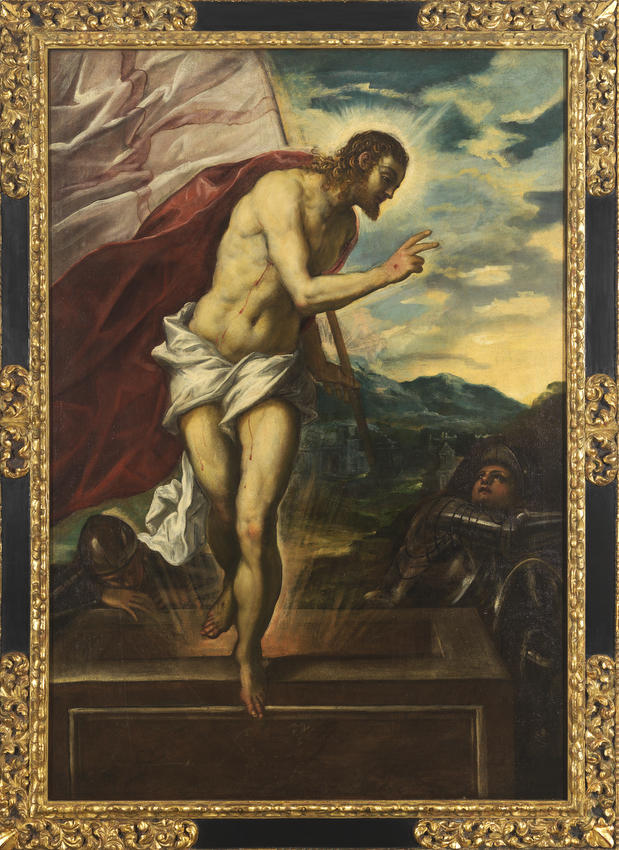We acknowledge the Traditional Owners of the land on which the Queensland Art Gallery | Gallery of Modern Art stands and recognise the creative contribution First Australians make to the art and culture of this country.

Jacopo Robusti Tintoretto / Venice 1518–94 / Cristo risorgente (The risen Christ) c.1555 / Oil on canvas / 201 x 139cm / Purchased 1981. Queensland Art Gallery Foundation / Collection: Queensland Art Gallery | Gallery of Modern Art
TintorettoCristo risorgente (The risen Christ) c.1555
On Display: QAG, Gallery 9
In this painting, Tintoretto has depicted the body of Jesus Christ rising from the tomb after Crucifixion. Jesus holds the staff of the resurrection banner and is delivering a gesture of blessing or benediction in the form of two raised fingers to the awakening soldier, while the other continues to sleep.
In the background, a rising sun indicates that it is dawn — light triumphs over darkness, just as Christ has triumphed over death. Tintoretto was known for using bold colours and lighting for dramatic effect, and we see this here in Christ’s unfurling crimson cloak, the blue–green of the morning sky and the rays of light emanating from the tomb.
Analysis of the materials and pigments used in the painting has revealed traces of lead white — a dense and opaque pigment, which, when mixed with other mineral pigments, would have produced a luminous effect in a candle-lit chapel.
The painting would have originally hung in a Venetian church, probably over an altar and high above the viewer. This partly explains the illusionistic foreshortening of the figure of Christ, who appears to be stepping out of the frame, creating a sense of three-dimensionality.
X-rays of the canvas have revealed that the position of the tomb was changed three times during the painting’s creation.
Jacopo Robusti Tintoretto was the son of a cloth-dyer (tintore), hence his name. Tintoretto is widely acknowledged as one of the masters of the Venetian Renaissance, along with Titian and Paolo Veronese.
A prolific painter, he spent almost his entire life in Venice. During his early career, he struggled to achieve recognition, which finally came in 1548 with a work commissioned for the Scuola Grande di San Marco. In his mature years, he worked extensively on decorations for the Doge’s Palace and for the meeting house of the Scuola Grande di San Rocco, which occupied his time for many years, from 1564 until 1567 and between 1575 and 1588.
Unlike Titian and Veronese, Tintoretto was never wholly accepted by the leading aristocratic families who dominated Venetian cultural life, and to an extent, this hindered his patronage. Despite a long and busy career, Tintoretto never became wealthy, and in 1600, his widow approached the Venetian state for financial help to support her family.
Discussion Questions
1. This painting was made for display in a church. How has Tintoretto used the elements of the painting to demonstrate the importance of Christ?
2. Analyse how Tintoretto has created a dynamic scene by exaggerating the contrast between the figurative and non-figurative elements in the work. Why does the figure of Christ appear to move forward whilst looking back?
Classroom Activities
1. Discuss a recent news event and, in small groups, dramatise the event. Focus on the placement and the movement of the characters in relation to each other. Take a photograph of the performance and use this as a tool to create a painting. Like Tintoretto, consider the use of line, shape and colour to present drama in the composition.
2. Focus on the relationship between the blue sky and the flesh-toned flag behind the figure of Christ in the painting. Attach a piece of coloured cloth to a branch or pole and photograph it in motion from a low angle, using the sky as your backdrop. Select one of the photographs to use as the basis for creating a pastel drawing or a painting.